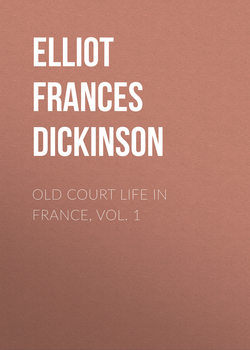Читать книгу Old Court Life in France, vol. 1 - Elliot Frances Minto Dickinson - Страница 16
CHAPTER XI.
THE WIDOWED QUEEN
ОглавлениеEVEN while the King lay dying, Catherine gave a taste of her vindictive character by ordering Diane de Poitiers instantly to quit the Louvre; to deliver up the crown jewels; and to make over the possession of the Château of Chenonceau, in Touraine, to herself. Chenonceau was Catherine’s “Naboth’s vineyard.” From a girl, when she had often visited it in company with her father-in-law, Francis, she had longed to possess this lovely woodland palace, beside the clear waters of the river Cher. To her inexpressible disgust, her husband, when he became King, presented it to “the old hag,” Diane, Duchesse de Valentinois.
When Diane, sitting lonely at the Louvre, for Henry II. was dying at the Palace des Tournelles received the Queen’s message, she turned indignantly to the messenger and angrily asked, “Is the King then dead?” “No, madame, but his wound is pronounced mortal; he cannot last out the day.”
“Tell the Queen,” said Diane haughtily, “that her reign has not yet begun. I am mistress over her and the kingdom as long as the King lives. If he dies I care little how much she insults me. I shall be too wretched even to heed her.”
As Regent, Catherine’s real character appeared. She revelled in power. Gifted with a masculine understanding and a thorough aptitude for state business, she was also inscrutable, stern, and cruel. She believed in no one, and had faith in nothing save the prediction of astrologers and the course of the stars, to which she gave unquestioning belief. As in the days of her girlhood, Catherine (always armed with a concealed dagger, its blade dipped in poison) traded on the weaknesses of those around her. She intrigued when she could not command, and fascinated the victim she dared not attack. All who stood in the way of her ambition were “removed.” None can tell how many she hurried to an untimely grave. The direful traditions of her race, the philters, the perfumes, the powders, swift and deadly poisons, were imported by her into France. Her cunning hands could infuse death into the fairest and the freshest flowers. She had poisons for gloves and handkerchiefs, for the folds of royal robes, for the edge of gemmed drinking cups, for rich and savory dishes. She stands accused of having poisoned the Queen of Navarre, mother of Henry IV.,8 in a pair of gloves; and, spite of the trial and execution of Sebastian Montecucolli, she was held guilty of having compassed the death of her brother-in-law, the Dauphin, in a cup of water, thus opening the throne for her husband and herself.
Within her brain, fertile in evil, was conceived the massacre of St. Bartholomew – to exceed the horrors of the Sicilian Vespers under John of Procida – the plan of which she discussed years before the event with Philip II. and his minister, the Duke of Alva, whom she met at Bayonne, when she visited there her daughter, Elizabeth of Spain. Catherine was true to no party and faithful to no creed. During her long government she cajoled alike Catholics and Protestants. She balanced Guise against Coligni, and Condé against Navarre, as suited her immediate purpose. Provided the end she proposed was attained, she cared nothing for the means. Although attached to her children in infancy, before supreme power had come within her grasp, she did not hesitate to sacrifice them later to her political intrigues.
For her youngest daughter – the bewitching Marguerite, frail Queen of Navarre – she cared not at all. Her autobiography is filled with details of her mother’s falseness and unkindness. As to her sons, all – save Francis, who died at eighteen – were initiated early into vice. Their hands were soon red with blood. Long before they reached manhood they were steeped in debauchery and left the cares of government entirely to their mother. Her Court – an oasis of delight and artistic repose, in an age of bloodshed (for Catherine was a true Medici, and loved artists and the art, splendour and expenditure) – was as fatal as the gardens of Armida to virtue, truth, and honour. She surrounded herself with dissipated nobles, subservient courtiers, venal nymphs, and impure enchantresses, all ready to barter their souls and bodies in the service of their Queen. The names of the forty noble demoiselles by whom Catherine was always attended, are duly recorded by Brantôme.
“Know, my cousin,” said the Queen, speaking to the Duc de Guise, “that my maids of honour are the best allies of the royal cause.”
She imported ready-witted Italians, actors and singers, who played at a theatre within the Hôtel Bourbon at Paris; saltimbanques and rope-dancers, who paraded the streets; astrologers, like Ruggiero; jewellers, like Zametti; and bankers, like Gondi. These men were ready to sell themselves for any infamy; to call on the stars for confirmation of their prophesies; to tempt spendthrift princes with ample supply of ready cash; to insinuate themselves into the confidence of unwary nobles; all to serve their royal mistress as spies.
A woman of such powerful mind, infinite resource, and unscrupulous will, overawed and oppressed her children. During the three successive reigns of her sons, Francis II., Charles IX., and Henry III., Catherine ruled with the iron hand of a mediæval despot. Yet her cruelty, perfidy, and statescraft, were worse than useless. She lived to see the chivalric race of Valois degraded; her favourite child Anjou, Henry III., driven like a dog from Paris, by Henri de Guise; and son after son go down childless to a dishonoured grave.
8
See Note 8.
